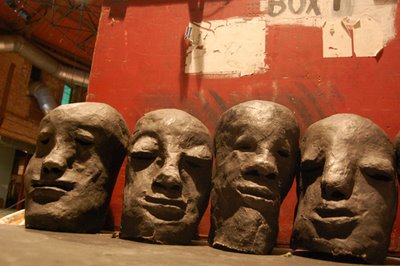Brandeis University’s board of trustees voted unanimously Monday to close the school’s Rose Art Museum, according to the school. Brandeis says it plans to shutter the museum late this summer, “publicly sell” off the more than 6,000 works in its collection via a “top auction house,” and convert the facility into “a fine arts teaching center with studio space and an exhibition gallery.”
The decision was described by the school “as part of a campus-wide effort to preserve the university’s educational mission in the face of the historic economic recession and financial crisis.”
“These are extraordinary times,” Brandeis President Jehuda Reinharz said in a press release. “We cannot control or fix the nation’s economic problems. We can only do what we have been entrusted to do —act responsibly with the best interests of our students and their futures foremost in mind.”
Rose Director Michael Rush could not be reached tonight for comment.
The decision to close the Rose, which opened in 1961, came as a shock to the Boston art community. In the past few years, the Rose has floated plans for expanding – going so far as exhibiting draft plans in the museum. And the museum was in the process of producing a major catalogue of its collection with Abrams Books.
On Dec. 17, the museum confirmed to me that it had
frozen its search for a new curator, a position that had been open since Raphaela Platow left the Rose for Cincinnati’s Contemporary Art Center in June 2007. The move was described then as part of an effort to reduce costs during the current international economic meltdown.
But Brandeis spokesman Dennis Nealon insisted in December that
"No, the university is not in an official, institution-wide hiring freeze. We are in the initial phases of a wide-ranging review of revenues and expenditures, involving input from all segments of the university community – from students to faculty to staff members – that is intended to get ideas and suggestions on how non-academic spending can be curtailed, and how Brandeis can best deal with the nationwide economic situation facing all colleges and universities. Individual departments are faced with having to make budget decisions of their own, and about freezing things etc., and it sounds like that is what Michael Rush has done with the position at the Rose. That's fine. That's his call. The university won't know for some months what the real, overall budget picture here is, once ideas and suggestions percolate up and the various committees at work here are done reviewing things. Then the board of trustees late this winter or so will make the real decisions.”
Apparently, things moved faster than expected.
Perhaps the decision to close the Rose and sell off the collection is Brandeis’s only option for survival, but it feels like the school is selling off its inheritance to survive a short-term problem. Plus, a down art market could mean that Brandeis may wind up selling its treasures for far less than they’re worth.
“The Rose Art Museum houses an outstanding collection of modern and contemporary art widely recognized as the finest of such collections in New England,” the institution’s website proclaims. In the region, only Harvard and Phillips Academy’s Addison Gallery’s collections of post World War II art rival it.
The nucleus of that collection was acquired by Sam Hunter, the museum’s visionary first director. Early on he bought major works by Andy Warhol, James Rosenquist, Robert Rauschenberg, Jasper Johns, Alex Katz, and Roy Lichtenstein.
The New York Times reports that Brandeis faces a budget shortfall that could reach $10 million. Among the treasures of the Rose’s collection is Warhol’s “Saturday Disaster” (1964), two stacked black and white screenprinted images of a fatal car crash. Christie’s auctioned off a 1963 Warhol car crash painting for a record price of $71.7 million in 2007, but the auction market collapsed in recent months. In November, the auction house failed to find a buyer for a 1973 Warhol portrait of Mao.
* * * * * *
Brandeis’s entire press release:With vote to close art museum, Brandeis renews ‘unwavering’ commitment to students, research and academic mission
WALTHAM, Mass., Jan. 26, 2009 — Brandeis University’s Board of Trustees today voted unanimously to close the Rose Art Museum as part of a campus-wide effort to preserve the university’s educational mission in the face of the historic economic recession and financial crisis.
Board members stressed that the museum decision will not alter the university’s commitment to the arts and the teaching of the arts.
“These are extraordinary times,” said Brandeis President Jehuda Reinharz. “We cannot control or fix the nation’s economic problems. We can only do what we have been entrusted to do — act responsibly with the best interests of our students and their futures foremost in mind.”
Opened in 1961, the Rose Art Museum houses a large amount of modern and Contemporary art. Plans call for the museum to close in late summer 2009, and transition into a fine arts teaching center with studio space and an exhibition gallery.
After necessary legal approvals and working with a top auction house, the university will publicly sell the art collection. Proceeds from the sale will be reinvested in the university to combat the far-reaching effects of the economic crisis, and fortify the university’s position for the future. Brandeis officials said the decision to close the museum is part of an emerging new vision for the university aimed at streamlining it for the future while bolstering its focus on undergraduates, the liberal arts and research.
In recent months, the university has been reviewing expenditures and discussing new initiatives to meet the serious economic challenges. Belt tightening has already brought substantial decreases in administrative budgets.
In a special session on Jan. 22, the Brandeis faculty voted unanimously to support the president and trustees as they combat the effects of the economic recession and work to make Brandeis stronger academically and fiscally for the 21st century. Faculty members agreed that the university should maintain the strengths that have helped position Brandeis among the nation’s top liberal arts and research institutions.
Brandeis officials have estimated that the economic recession will continue to adversely affect operating expenses, performance of the endowment, financial aid and scholarships. At Brandeis and schools around the country, fund-raising revenue is declining and families are looking for more financial aid to help them cope with their own unenviable economic straits.
Reinharz said the Rose Museum decision was very difficult. But he characterized it as an important step in the ongoing resource management and allocation process on the school’s campus. “I am satisfied that our commitment is unwavering; that someday we will look back and say that when the quality of education and student services was at stake, we made hard choices so that Brandeis could emerge even stronger.”
* * * * * *
Dear readers, please contact me here if you've got info to share about the Rose or Brandeis.Our Brandeis and Rose reports:Brandeis’s
liquidator-in-chief.
The first painting Brandeis should
pawn.
Question: Brandeis
financial management?
Brandeis
president’s e-mail on Rose.
AG on Brandeis's plans.
Brandeis’s
money.
Update: Brandeis to close Rose,
sell art.
Brandeis to
close Rose.
















